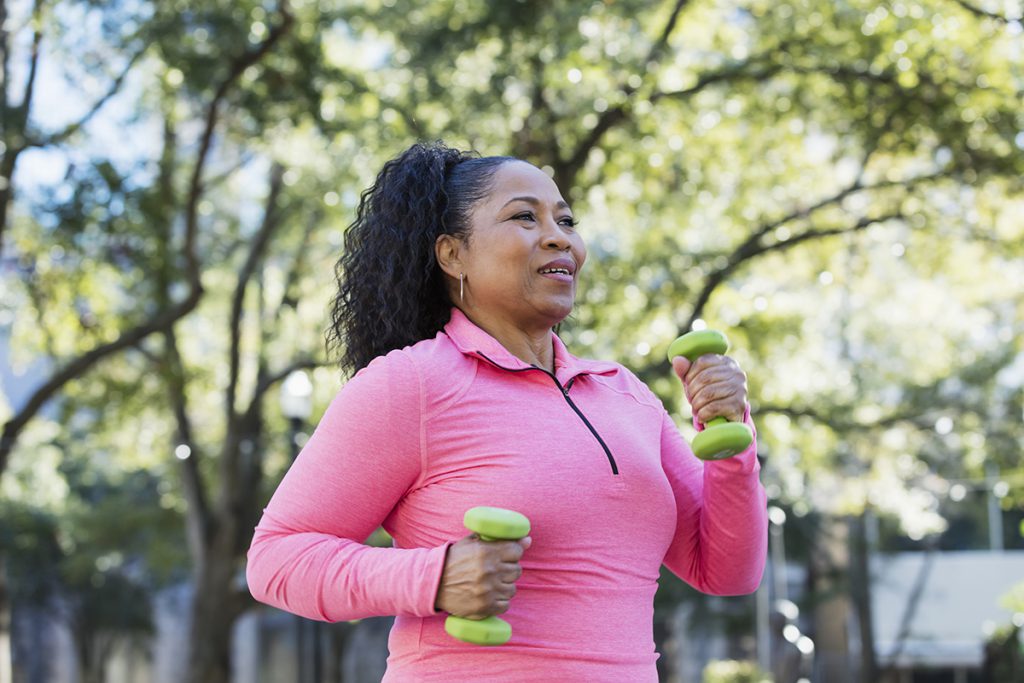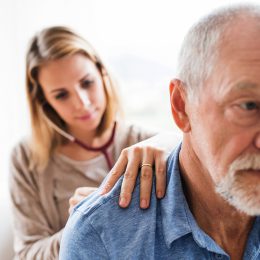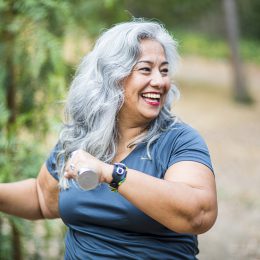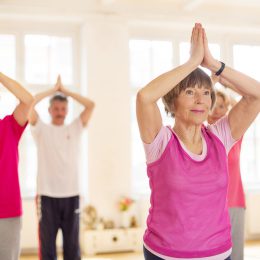6 Reasons You’ve Hit a Weight Loss Plateau
You’re getting plenty of exercise, but the scale seems stuck. Sound familiar? Use these tips to break through a weight loss plateau.

It’s weight loss 101: To drop pounds, trim belly fat, and gain more lean muscle, you need to bump up your workout cadence.
But if the scale isn’t budging after a few weeks, despite the extra sweat sessions, it’s only natural to wonder what all the extra effort is for.
“When it comes to weight loss, a workout is only one component,” says Carrie Boe, C.P.T. She is a personal trainer and senior fitness specialist at Life Time, which runs fitness centers across the United States. “If you’re not seeing progress, it’s possible you’re not taking the other factors into consideration.”
Seniors trying to lose weight also need to account for natural declines in muscle mass, metabolism changes, and more, Boe explains. So if you’ve found yourself up against a weight-loss plateau, check that you’re also addressing these six factors.
Stay active, have fun, get fit — with SilverSneakers! Classes and events are happening right now at participating gyms, online through SilverSneakers LIVE, and at community centers near you. Activate your free online account to get started.
1. You’re Exercising More, But Moving Less Throughout Your Day
Congrats! You’re hitting your exercise targets. You’ve earned that couch time. Right?
Not exactly.
“I’d rather see my clients moving throughout their day rather than doing just one hour of an exercise class and then just sitting for hours on end,” says Boe. “Please remember that we don’t move to just lose weight but to truly impact our overall health and wellness. That means for improved energy, better rest, and keeping our muscles and joints flexible.”
The U.S. Department of Health Physical Activity Guidelines call for 150-minutes of moderate-intensity aerobic exercise each week, like brisk walking or Zumba classes.
If you’re already meeting those guidelines, you’re off to a solid start. But what are you doing during the rest of your week?
Becoming more sedentary is common with aging, research suggests. When participants in a 2020 study hit retirement age, they became significantly more sedentary. In other words, they sat around more. Researchers found that this new habit became tough to break. They published their findings in the journal Occupational & Environmental Medicine.
There are easy ways to add more activity to your day, says Boe. A few ideas:
- Take the stairs instead the elevator
- Walk while you’re on the phone
- Play music that makes you want to dance
- Find active games to play with your pet
- Spread household chores throughout your day
2. You’re Not Getting Quality Sleep
Another surprising contributor to weight loss plateaus? Not getting enough sleep.
Adults need about 7 to 9 hours of solid shuteye. Shortchanging your sleep needs can increase levels of the hormone that signals hunger, called ghrelin. Being well rested also helps keep inflammation at bay.
Sleep problems are well documented in older adults. Insomnia and nocturia (a health problem that leads to excessive nighttime urination) are both more common as you get older. That’s why it’s especially important to take time to focus on building solid sleep habits.
“Sufficient sleep is a foundational component to our health and wellness, especially as we age,” says Boe. “The good news is that as you get more movement throughout the day and establish a regular fitness routine, that can improve sleep quality, and help with weight loss as a result.”
Recommended reading: The Best Medicine? A Good Night’s Sleep
3. You’re Not Allowing Enough Time for Recovery
Maybe you’re enthusiastic about working out, so you make sure to get plenty of intense exercise every day — maybe even a couple times per day.
Despite your good intentions, you may be sabotaging yourself. Why? You’re asking too much of your body.
“Our bodies need to rest from training,” says Boe. “Lack of proper recovery takes its toll on our system.”
For example, if you’re doing five or six cardio workouts each week, your body needs two recovery days.
“Recovery is just as vital as the workout itself,” says Boe.
Keep in mind there’s a right and wrong way to approach your recovery days, she adds.
- Wrong: Parking yourself on the couch.
- Right: Going for a leisurely walk or doing a yoga class.
Remember tip No. 1 and find gentle ways to move.
4. You’re Skimping on Hydration
You’ve heard it many times before: Drink more water. But it’s worth repeating. Research shows that many older adults simply don’t get enough.
According to the National Council on Aging, up to 40% of people over age 65 may be chronically underhydrated, in part because thirst tends to diminish with age. Your body may not send you signals when it’s in desperate need of fluids.
Hydration is key for a number of physical functions, and weight loss is one of those. A study in Frontiers in Nutrition found that increased hydration is connected to decreased fat, to the point where it may be a factor in lowering risk of obesity and type 2 diabetes.
“If you’re worried about increasing your water intake and then needing to run to the restroom all the time, make sure to progress gradually to your hydration goals,” suggests Boe. “Your body will adapt.”
Recommended FREE SilverSneakers On-Demand Class: Body Hydration Tips for Seniors
Subscribe to our newsletter
It's quick and easy. You could be one of the 13 million people who are eligible.
Already a member? Click to discover our 15,000+ participating locations.
Follow Us
5. You’re Trying to Outrun a Bad Diet
There’s an old saying in the fitness community: Muscles are made in the gym, but fat is lost in the kitchen.
That means you can’t simply “burn off” excess calories by doing more workouts — you need to make some changes to your eating habits too.
“The prevailing belief is that there’s a point at which it’s too late to gain muscle mass back, but that’s simply not true,” says Stephen Perrine, co-author of The Whole Body Reset. “It’s shocking to me how many people believe gaining weight and losing strength is just a ’normal’ part of aging when it doesn’t have to be the case.”
You can learn more about Perrine’s Whole Body Reset tips here, but the key highlights are:
- Get more protein in the morning and less in the evening
- Don’t restrict calories since that can cause your body to hold on to weight
- Eat more healthy fats like extra-virgin olive oil because it helps you feel full for longer
- Choose full-fat dairy, since it’s been linked to reduced risk of obesity
“We’re all guilty of searching for the magic bullet when it comes to eating for fat loss,” adds Boe. “But so many approaches are very difficult to maintain, and results are often short-lived. Establishing good habits that feel foundational and achievable are key.”
6. You’re Not Strength Training
Although cardio has its place, resistance exercise that involves bodyweight or weights — such as dumbbells, kettlebells, or
“One study found that when people in their 60s combined a high-quality protein meal and resistance exercise, their bodies responded in the same way as the bodies of people in their 20s,” he adds.
To get started with strength training:
- Try the weight machines at the gym. You’ll find detailed instructions on each machine to use as a guide.
- Look for a SilverSneakers Classic or Circuit Both will give you a taste of using resistance tubing and handheld weights.
“By incorporating workouts built around resistance training, you can still increase muscle mass as you get older,” says Boe. “This type of exercise also improves bone health and can help increase metabolism.”
Remembering all these strategies might seem overwhelming, but Boe suggests tackling one at a time. After a few weeks, you’ll notice that scale moving again.
See our sources:
Physical activity guidelines for Americans: U.S. Department of Health and Human Services
Study on sedentary behavior after retirement: Occupational & Environmental Medicine
Study on link between quality of sleep and weight: BMJ Open Sport & Exercise Medicine
Hydration guidelines for older adults: National Council on Aging
Study on link between hydration and weight loss: Frontiers in Nutrition
Check Your SilverSneakers Eligibility Instantly
SilverSneakers members can go to thousands of nationwide gyms and fitness locations, plus take SilverSneakers LIVE online classes that are designed for all fitness levels and abilities. If you have a Medicare Advantage plan, it may include SilverSneakers — at no additional cost. Check your eligibility instantly here.
Already a member? Get your SilverSneakers member ID and exclusive fitness and wellness content by activating your online account here.
Not eligible for SilverSneakers? You can still get 200+ free SilverSneakers On-Demand videos and stay in touch with us by creating your online account.





